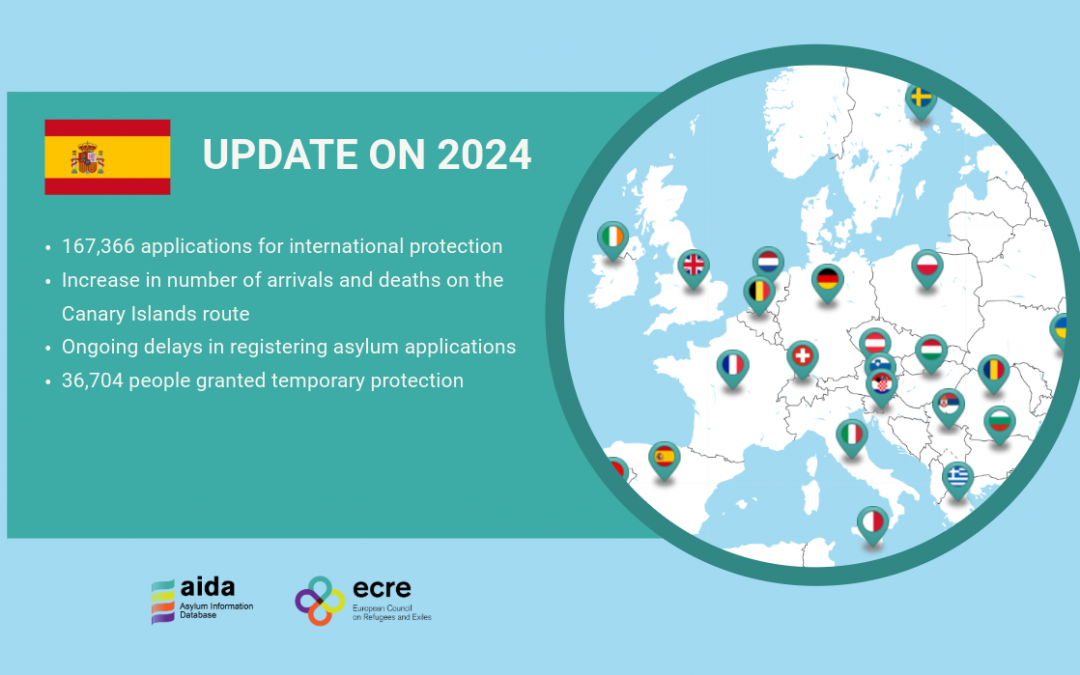The updated AIDA Country Report on Spain provides a detailed overview on legislative and practice-related developments in asylum procedures, reception conditions, detention of asylum applicants and content of international protection in 2024. It is accompanied by an annex which provides an overview of temporary protection.
A number of key developments drawn from the overview of the main changes that have taken place since the publication of the update on 2023 are set out below.
Statistics
- Asylum applications and decisions: Spain received 167,366 asylum applications in 2024. 164,010 of them were from first-time applicants and the main countries of origin were Venezuela, Colombia, Mali, Peru and Senegal. Of the decisions made, 6,355 people were granted refugee status, 11,453 people were granted subsidiary protection and 33,535 people were granted humanitarian protection. The recognition rate for refugee and subsidiary protection was 19.8 (57% including humanitarian status). At the end of 2024, there were 133,102 first instance applications pending.
Asylum procedure
- Access to the territory: 63,970 people reached Spain by irregular land and sea routes in 2024. This represented a 7.1% increase from the previous year. 46,843 of the arrivals were via the Canary Islands route. An NGO has estimated that 10,457 people, including over 1,500 children and 400 women, died attempting to reach Spain in 2024, and that the vast majority of the deaths occurred along the Canary Islands route.
- Delays in registration: People seeking asylum continued to experience lengthy waiting times for appointments to lodge applications in 2024. This prompted protests and a complaint to the Ombudsperson.
Reception conditions
- Challenges in the treatment of unaccompanied minors: The Canary Islands continued to face pressure due to the arrival of large numbers of unaccompanied minors (UAMs). Although the central government presented a relocation plan for 2,500 UAMs, a broader compulsory distribution plan was rejected by the The United Nations Refugee Agency (UNHCR) and civil society organisations have called for improved responsibility sharing between the various autonomous communities.
Detention of asylum applicants
- Overcrowding and poor conditions at Madrid Airport: The asylum facilities in Madrid’s Barajas Airport were overwhelmed in mid-2024, in part due to the number of applications submitted by Mauritanian nationals. Legal and structural deficiencies, including a lack of interpreters and basic resources, led to concerns over access to procedures and legal assistance.
Content of international protection
- Access to rights: Obstacles in access to housing, employment and banking services persisted in 2024, particularly for vulnerable groups such as UAMs and LGBTQIA+ people.
- Reform of the Immigration Law: A new regulation aimed at regularising up to 300,000 people was adopted in late 2024. However, NGOs criticised the lack of provisions for regularising asylum applicants whose cases were pending. Legal challenges were brought against aspects of the law in early 2025, particularly the exclusion of time spent as asylum applicants from eligibility for residence permits based on “arraigo”.
Temporary protection
- Statistics and funding: As of February 2025, 236,570 people fleeing Ukraine had been granted temporary protection in Spain, including 36,704 in 2024. Since the start of the full-scale invasion of Ukraine in February 2022, Spain has allocated over €1.53 billion to support people fleeing the country.
- Access to services: Beneficiaries of temporary protection in Spain have immediate access to the labour market and education. By the end of 2024, over 28,000 adults were in employment (mainly hospitality and construction) and almost 40,000 children were enrolled in education. A multilingual information phone line was launched in October 2024.
The full report is available here and the annex on temporary protection is available here.
For more information about the AIDA database or to read other AIDA reports, please visit the AIDA website.

